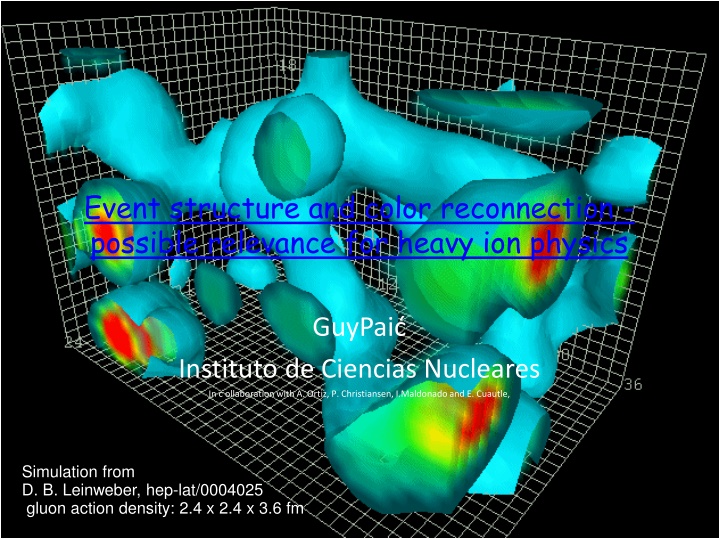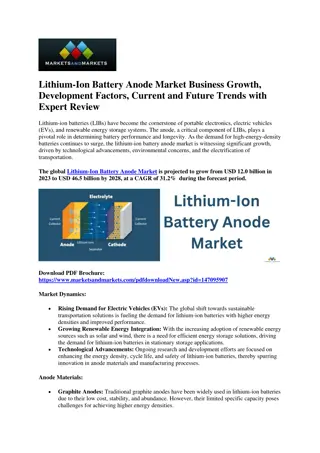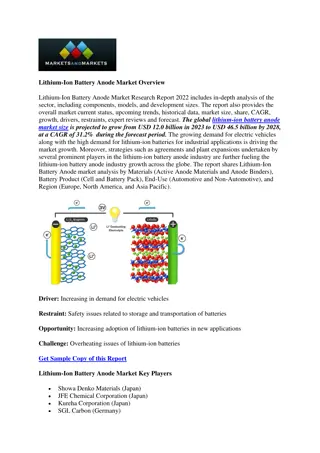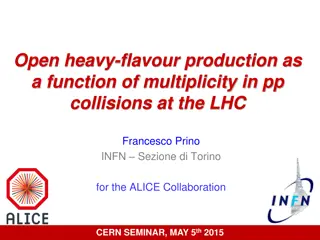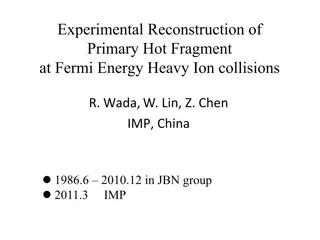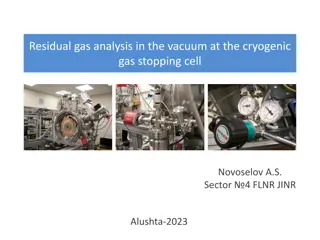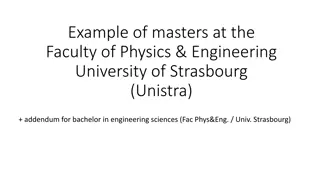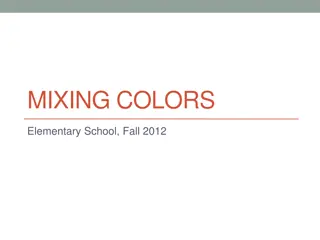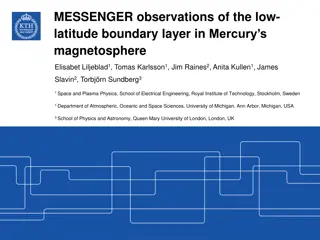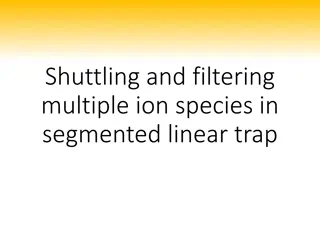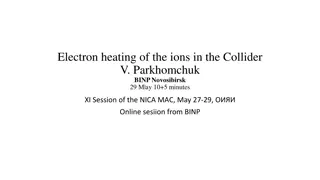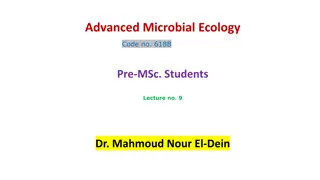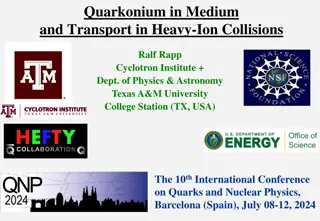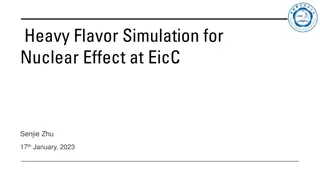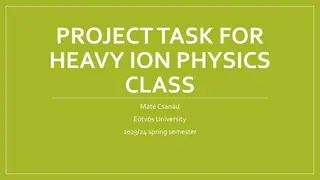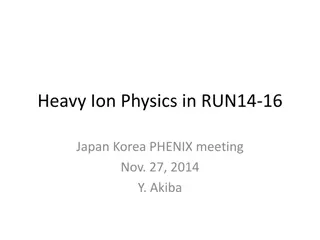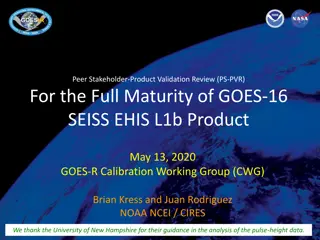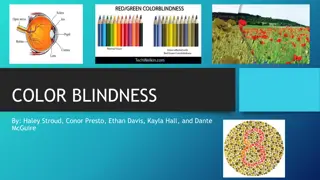Event Structure and Color Reconnection in Heavy Ion Physics
Investigating event structures in proton-proton collisions sheds light on potential relevance for heavy ion physics, especially in understanding parton energy loss and hydrodynamic flow dynamics. The study discusses phenomena like color reconnection, underlying events in Pythia, and multiple-parton interactions. The analysis of event structures and transverse sphericity provides valuable insights into particle collisions and the intricacies of partonic interactions. Collaboration between researchers continues to explore the event structure at a detailed level to uncover new facets in high-energy physics.
Download Presentation

Please find below an Image/Link to download the presentation.
The content on the website is provided AS IS for your information and personal use only. It may not be sold, licensed, or shared on other websites without obtaining consent from the author.If you encounter any issues during the download, it is possible that the publisher has removed the file from their server.
You are allowed to download the files provided on this website for personal or commercial use, subject to the condition that they are used lawfully. All files are the property of their respective owners.
The content on the website is provided AS IS for your information and personal use only. It may not be sold, licensed, or shared on other websites without obtaining consent from the author.
E N D
Presentation Transcript
Event structure and color reconnection - possible relevance for heavy ion physics GuyPai Instituto de Ciencias Nucleares In c ollaborationwith A. Ortiz, P. Christiansen, I.Maldonadoand E. Cuautle, Simulation from D. B. Leinweber, hep-lat/0004025 gluon action density: 2.4 x 2.4 x 3.6 fm
The message the LHC has allowed us to investigate the pp collisions in great details: an opportunity we have not yet fully exploited In spite of the good statistics we remain steadfastly in the averaging process applying the analysis of the event structure of pp events in function of multiplicity may have relevance to heavy ion results on parton energy loss The hydrodynamic flow confronted with partonic level interactions like color reconnection in pp sharpens the debate 25/09/2013 Guy Paic 2
Underlying event in Pythia: MPI (CR), ISR, BR 25/09/2013 Guy Paic
The Inelastic Non-Diffractive Cross-Section Occasionally one of the parton-parton collisions is hard (pT > 2 GeV/c) From Rick Field Proton Proton Majority of min- bias events! Semi-hard parton- parton collision (pT < 2 GeV/c) + Proton Proton Proton Proton + + Proton Proton Proton Proton the pp collision is ~ an average of all processes Multiple-parton interactions (MPI)! Guy Paic 25/09/2013
from earlier experiments: how wrong we can be CDF Chriss Quigg: arXiv:1004.0975v1 [hep-ph] Albajar, C., et al. (UA1 Collaboration). Analysis of the Highest Transverse Energy Events Seen in the UA1 Detector at the SppS Collider. Z. Phys. C36 (1987), UA1 25/09/2013 Guy Paic 5
Introducing the event structure variable transverse velocity 25/09/2013 Guy Paic 6
The transverse sphericity from a pencil to a hedgehog 25/09/2013 Guy Paic 7
25/09/2013 Guy Paic Guy Paic
Multiparton interactions and multiplicity distribution A clear dependence on multiplicity From A. Ortiz central peripheral What can be expected in the tail of the MPI/multiplicity? Collectivity? 25/09/2013 Guy Paic 9
The multiplicity is strongly dependent on the MPI At low multiplicity the effect is negligible. http://home.fnal.gov/~skands/leshouches- plots/lhc07m-19-1.png We need to study the high multiplicities in detail! Note: the MB is dominated by the low multiplicities. Not seeing the high multiplicities occults the importance of MPI 25/09/2013 Guy Paic Guy Paic
The sphericity spectrum in bins of multiplicity The general trend with multiplicity is trivial: more multiplicity > sphericity rises Detail: do the generators reproduce the trend? Actually not! The generator sphericity spectra CROSS the experimental spectrum at ST of 0.5 at low multiplicity and 0.7 at the highest multiplicities ALICE Collaboration Eur.Phys.J. C72 (2012) 2124 We show here that the higher sphericity of high-multiplicity events compared to MC predictions is due to an apparent reduction of the relative jet yields in such type of events (from properties in low and high multiplicity events in p-p collisions at 7 TeV CMS Collaboration CMS-PAS-FSQ-12-022
Questions Can we talk of fluctuations in the pp events or we do have two very distinct mechanisms which may be connected with the number of multiparton interactions and or centrality dependence of the pp collisions (like in heavy ions)? 25/09/2013 Guy Paic 12
The next big question: is flow existing in pp collisions? Ortiz et al. Phys. Rev. Lett. 111, 042001 (2013) 25/09/2013 Guy Paic
From pp to PbPb not much change! Can the theory coherently explain??? 25/09/2013 Guy Paic 14
Color reconnection In Pythia, the final step at parton level before the hadronization is the color reconnection CR, its aim is to describe the hadronization of a many parton system in a single event with multiple hard sub collisions. Toy model of (non-perturbative) color reconnections, applicable to any final state at hadronisation time, each string piece has a probability to interact with the vacuum / other strings: Preconnect = 1 (1- )n = strength parameter: fundamental reconnection probability (free parameter) n = number of multiple interactions in current event ( ~ counts # of possible interactions) G. Gustafson, Acta Phys.Polon.B40:1981- 1996,2009 25/09/2013 Guy Paic 15
Effect of multiparton interactions and color reconnection on observables with identified hadrons Guy Paic 25/09/2013
p/ vs pT and MPI The dependence with MPI (multiplicity) resembles the evolution of the p/pi vs pT from peripheral to central Pb-Pb collisions. Dependence of the non-strange baryon-to-meson ratio with the number of MPI's, Nmpi. For with Nmpi>5 the ratios exhibit the peak. The peak is enhanced w.r.t. reference when Nmpi increases, Nmpi>10. Also the peak is pushed up to higher pT (characteristic of flow). ALICE Collaboration, http://arxiv.org/abs/1303.0737 25/09/2013 Guy Paic
/K0 S vs pT and MPI Same for Lambda-to-K0 function of pT S ratio as a 25/09/2013 Guy Paic
Effect of CR on the p/ ratio vs pT The peak on p/ is due to color reconnection 4/17/2013 25/09/2013 guy paic Guy Paic 19 Guy Paic
Is this just a baryon effect? Is this just a baryon effect? No! We have a mass effect=flow-like 25/09/2013 Guy Paic
Other observables with identified hadrons The behavior of the double ratios indicates that we have a mass effect since the / and the p/ ratios exhibit a much larger bump than the K/ ratio. We know that Pythia underestimates the strange particle production, specially at intermediate pT. To avoid this problem we can look at the <pT> vs Nch. 4/17/2013 25/09/2013 guy paic Guy Paic 21 Guy Paic
<pT> as a function of multiplicity Pythia describes the data when CR is implemented, i.e. a flow-like effect is necessary. So far we know that MC generators are too hard, very jetty-like. See transverse sphericity as a function of the event multiplicity. More MPI activity best describes data -> more isotropic - >larger flow-like effect. CMS Collaboration, Eur. Phys. J. C 72 (2012) 2164 25/09/2013 Guy Paic
Conclusion For the first time (unknown to the author of Pythia 8) we have proven that color reconnection does produce effects similar to flow but only up to a limit in pt. The effect of the CR does weaken at higher momenta as also requested by the data, The fact of having some kind of collectivity without the introduction of often complicated hydrodynamics arguments (thermalisation, temperature time sequence etc) seems interesting and its application to heavy ion collisions could be full of surprises!! 25/09/2013 Guy Paic
speculations we seem to have pinpointed a mechanism that can generate flow like patterns. However a priori I do not see a mechanism that prevents having something similar a color reconnection that throws particles in eta. Ridge? The ridge spectra lie in the same pt range where CR is present 25/09/2013 Guy Paic 24
A short excursion in heavy ions The similarities observed in the p/pi and T-beta behavior asks an obvious question: is all what we have seen and liked so far in heavy ion already present in pp!? One of the sacred cows of the field is the parton energy loss If one takes a view from the side of pp one may say that the effect is already seen in pp!! 25/09/2013 Guy Paic 25
Comparison of high and low sphericity spectra in Pythia 8 4C By now it is well established by LHC experiments that in high multiplicity events the jets are suppressed at high multiplicities in pp collisions We have made a simulation with Pythia 8. The simulations show the same trend although in real data it is yet more marked 25/09/2013 Guy Paic 26
Ratio of low sphericity to high sphericity pt spectra The ratios show an interesting pattern that bears some similarities to what is observed in Heavy ion collisions and is attributed to parton energy loss Are we witnessing two different mechanisms of suppression or we witness the same in pp and heavy ions??? 25/09/2013 Guy Paic 27
The elliptic flow could it be MPI dependent. coordinate space Less MPI y More MPI More MPI x One should take in account that also the initial state is different with respect to the number of interaction if a collective effect like MPI and color reconnection takes place it should be taken into account. Guy Paic 25/09/2013 28
Long-range near-side angular correlations 7 TeV Peaks are truncated ! new ridge-like structure at ~ 0 25/09/2013 Guy Paic 29
Final comments We have seen that the pp collisions should be studied not only in minimum bias and/or multiplicity the event shapes should be taken into account Some features of the heavy ion collisions can be observed in the pp collisions at high multiplicity The pp collisions with a good statistics should be planned for the next LHC run in 2015 in good conditions with low pileup and high stats top reach higher multiplicities 25/09/2013 Guy Paic 30
25/09/2013 Guy Paic 31
